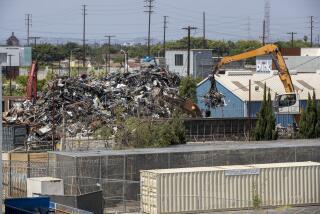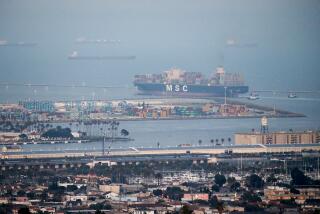China Uses L.A. Guide in Search for Scrap Iron
- Share via
SAN DIEGO — China is shopping for ships.
A delegation, consisting of four executives of China’s National Shipbreaking Corp., recently visited San Diego, looking for obsolete ships that could be taken back to China and torn up for scrap iron.
The Chinese say they want to buy as many as 20 cargo and tanker ships per month that can be sailed or towed back to China and then broken up at one of the country’s 120 shipbreaking, or ship scrapping sites. The scrap would then be recycled at Chinese steel mills.
To help locate ships, the Chinese formed a venture with Pacific Link International, a Los Angeles-based trade and brokerage firm co-founded by Eugene Allen, a former international operations director for Xerox whose territory included China. Allen’s partner is Ning Chien Sun, a Taiwan native educated in the People’s Republic of China who taught physics at the University of Southern California before going into business.
Asbestos Danger
The visit by the Chinese to San Diego and to several other U.S. ports and their formation of the venture with Pacific Link underscores the heightened demand for ships as scrap metal. Allen, who said he is looking all over the world for boats, said he is competing for ships with South Korea, Taiwan, the Philippines, India, Greece and Turkey, all leading consumers of scrap iron from recycled ships.
Shipbreaking makes sense in those countries because of low labor costs and less stringent environmental laws compared to those in the United States. Little shipbreaking is done here, sources say, because of high labor costs and the pervasive presence of asbestos in ships, requiring costly containment measures to conform with U.S. environmental laws.
In a broader sense, the visit by the Chinese and their aggressive search for obsolete ships also demonstrates the strength of the scrap iron market. Higher steel prices and increased production in steel mills abroad and in the United States, where mills have operated at more than 80% capacity recently, has created a huge demand for scrap iron. Scrap is used in the production of half the steel used in the Unites States annually.
Prices of scrap iron are reflecting the higher demand. According to American Metal Market trade newspaper, shredded scrap iron prices reached a 13-year high in November of more than $130 per ton. Although prices since have eased, scrap iron is still selling for more than the $85- to $95-per-ton price seen over most of the first half of 1987.
The demand for scrap, both in the United States and in countries such as China, has increased with the proliferation of electric steel furnaces that require a much smaller capital investment than open hearth and oxygen furnaces used in “integrated” steel mills that produce steel from iron ore. Electric steel furnaces, which run exclusively on steel scrap, have driven the expansion of so-called mini-mills in the United States.
Also adding to scrap iron demand is the fact that many integrated mills have added electric furnaces to their plants, giving them an expanded capability of producing steel from scrap iron, said Michael Marley, editor of Iron Age, a Radnor, Pa.-based trade magazine.
Foreign customers, including China, have become increasingly strong players in the U.S. scrap iron market. About 20% of the scrap metal collected in the Unites States each year in exported, according to the Institute of Scrap Recycling Industries, a Washington-based trade group.
Li Jizhang, president of China’s National Shipbreaking Corp., said in an interview here that the shortage of iron ore in China and the huge investment required to process it has forced China to emphasize recycling of scrap iron to satisfy its steel demand. Steel produced from scrap costs less than half of steel produced from ore, industry sources said.
Other Sources of Scrap
Li Jizhang said that the shipbreaking industry has been an on-again, off-again affair in China for the past 20 years, but that since 1983 a new emphasis had been placed on it as China’s industrial growth and business contacts with foreign countries has accelerated .
In past years, the Chinese were limited in the number of ships they could buy here by trade restrictions imposed by the U.S. government. But many of those restrictions have been lifted in recent years to the point that now the Chinese can even bid for the one or two obsolete Navy ships placed for auction every month, Allen said.
“Our contract calls for us to aid them in the identification and acquisition of ships with high steel content and to deliver them to China,” Allen said, adding that he seeks ships 400 feet or longer that weigh at least 4,000 tons. “Our first preference is that they be able to make it to China. Failing that, we’ll tow them over.”
Scrap iron takes many forms in addition to ships. About half of scrap used in U.S. steel production, for example, is “home” scrap created at processing and stamping mills as a byproduct of steel production. But the remainder is “purchased” scrap that comes in the form of recycled ships, automobiles, railroad cars and rails and old bridges.
The availability of ships for sale, Allen said, generally depends on the oil market and freight rates. In an oil glut, oil tankers are often idle and available at good prices. The same happens with cargo ships when when freight rates are high. Lately, “boats have been hard to come by,” Allen said, because the oil market had seemed to be firming before the recent meeting of OPEC and because oceangoing freight rates have dropped.
Richard New, manager of Hugo Neu-Proler Co., a major U.S. exporter of scrap iron with operations at Terminal Island here, said the scrap iron market is a series of “peaks and valleys” and is every bit as volatile as the stock market. Scrap iron prices have dropped 25% from the November peak, New said, because “there is doubt in the world that America is serious about curing the deficit.”
More to Read
Inside the business of entertainment
The Wide Shot brings you news, analysis and insights on everything from streaming wars to production — and what it all means for the future.
You may occasionally receive promotional content from the Los Angeles Times.










